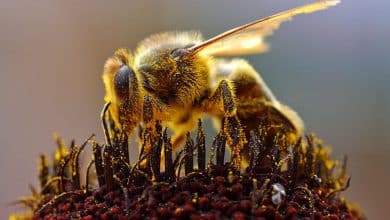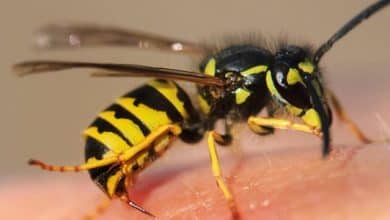Top Threats to Bee Health and How We Can Help

Bee Health play an indispensable role in maintaining the balance of our ecosystem. As primary pollinators, they are responsible for the reproduction of many flowering plants, including crops that humans rely on for food. In fact, it is estimated that one-third of the food consumed globally is made possible through pollination by bees and other insects. The intricate relationship between bees and plants facilitates biodiversity and ensures the sustenance of various animal species. Here are some key points that highlight their importance:
- Food Production: Bees are crucial for the pollination of fruits, vegetables, and nuts. Without their pollination, these crops would suffer significantly, leading to decreased yields.
- Biodiversity: By aiding the reproduction of plants, bees contribute to healthier ecosystems, thus supporting diverse wildlife and enhancing habitats.
- Agricultural Economy: The economic value of bee pollination services is estimated to be in the billions, making them vital to local and global food systems.
Overview of the top threats to bee health
Despite their critical role in the environment, bees face a multitude of threats that jeopardize their survival. Understanding these threats is paramount for any conservation effort. The most pressing challenges include:
- Climate Change: Fluctuating temperatures and extreme weather patterns disrupt the natural cycles of flowering plants and bee activity. This misalignment can lead to food shortages for bees.
- Habitat Loss and Fragmentation: Urban development, agricultural expansion, and deforestation have drastically reduced the availability of safe nesting sites and diverse food sources for bees.
- Invasive Plants and Bees: Invasive species can outcompete native plants, altering the landscape in a way that reduces the availability of resources needed by native bee populations.
- Low Genetic Diversity: Limited genetic variability in bee populations makes them more susceptible to diseases and environmental stressors.
- Pathogens Spread by Commercially Managed Bees: The movement of commercially managed bees can spread harmful pathogens, negatively affecting wild bee populations.
Recognizing these threats is the first step toward developing effective strategies to promote bee health and ensure their continued contribution to our environment.

Contents
Pesticides and Bee Health
Impact of pesticides on bee populations
Pesticides are widely used in agriculture and landscaping to manage pests, but their effects on bee populations are alarming. Honey bees and other native bee species are especially vulnerable to these chemical treatments, which can disrupt their natural behaviors and overall health. The use of synthetic pesticides, particularly neonicotinoids, has raised significant concerns. These chemicals can:
- Disorient Bees: Pesticides can interfere with a bee’s navigation abilities, making it difficult for them to find their way back to the hive.
- Reduce Lifespan: Exposure to certain pesticides can lead to increased mortality rates, affecting entire colonies and subsequently impacting local ecosystems.
- Compromise Reproduction: Chemicals can harm queen bees and their ability to reproduce, causing declines in colony populations.
- Increase Susceptibility to Diseases: Pesticide use weakens bee immune systems, making them more prone to diseases and parasitic infections.
Studies have documented a correlation between pesticide use and the decline in bee populations, which threatens not just these essential pollinators but also the plants and crops that rely on them for fertilization.
Ways to reduce pesticide exposure for bees
As individuals and communities grow increasingly aware of the importance of bee health, specific actions can be taken to minimize exposure to harmful pesticides. Here are some practical strategies to protect bees:
- Go Chemical-Free: Wherever possible, adopt organic gardening practices that avoid synthetic pesticides, fertilizers, and herbicides. This creates a safer environment for bees to thrive.
- Select Native Plants: Planting native flowers is crucial for bees, as many species have coevolved with these plants and rely on them for survival. Look for local varieties that bloom at different times throughout the seasons.
- Timing Matters: If you must apply pesticides, do so in the evening when bees are less active. Avoid spraying blooming plants to reduce direct exposure.
- Educate Others: Share information about the importance of bee health and sustainable practices with friends and neighbors. The more people who are aware, the more collective action can be taken.
- Create Bee-Friendly Zones: Designate areas in gardens or community spaces specifically for pollinators, filled with pesticide-free flowers that provide essential nectar and pollen.
By implementing these actions, everyone can contribute to the well-being of bee populations and help mitigate the negative impacts of pesticides on their health.
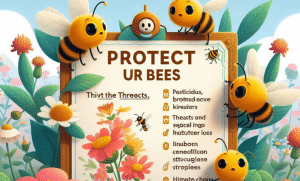
Habitat Loss and Bee Health
Effects of habitat loss on bee nesting and foraging
Habitat loss is one of the leading threats to bee populations worldwide. As urbanization, agricultural expansion, and deforestation continue to escalate, the natural environments that bees depend on for nesting and foraging are rapidly disappearing. The consequences of habitat loss on bees are profound:
- Nesting Sites: Many bee species require specific types of habitats for nesting, such as undisturbed soil, dead trees, or specific plants. The destruction of these habitats limits their ability to build homes and raise their young successfully.
- Foraging Resources: Bees rely on a variety of flowers for nectar and pollen, which are vital food sources. A loss of biodiversity can lead to a decrease in available food, impacting their nutrition and overall health.
- Fragmentation: Even when some habitats remain, their fragmentation into smaller patches can make it challenging for bees to navigate between them. This isolation can result in decreased gene flow and genetic diversity, further threatening bee populations.
- Increased Competition: With fewer foraging opportunities, native bees may face increased competition from invasive plant species that may not provide appropriate nutrition or could outcompete native flora for resources.
Initiatives to protect and restore bee habitats
Awareness of the critical need to protect and restore bee habitats has led to various initiatives aimed at reversing the detrimental trend of habitat loss. Here are some vital programs and actions being implemented:
- Pollinator Gardens: Communities and individuals are encouraged to create pollinator gardens filled with native flowers that bloom in different seasons. These gardens serve as safe havens, providing essential forage and shelter for bees.
- Habitat Restoration Projects: Conservation organizations are focusing on restoring degraded lands and replanting native vegetation. These efforts aim to create larger, interconnected habitats for bees and other pollinators.
- Land-use Planning: Policies promoting sustainable land-use practices can prevent habitat destruction. This includes integrating green spaces into urban development and advocating for organic farming practices.
- Education & Advocacy: Educational campaigns aim to inform the public about the importance of bees and the impacts of habitat loss. By raising awareness, these initiatives inspire individuals to participate in conservation efforts.
- Community Events: Many organizations host community events such as tree planting days, wildflower sowing, and workshops aimed at fostering bee-friendly practices in residential and agricultural settings.
By participating in these initiatives, individuals and communities can contribute to creating a supportive environment for bees, ensuring their survival for future generations.
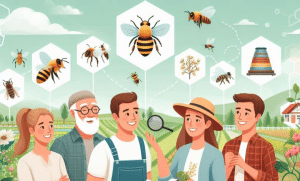
Climate Change and Bee Health
How climate change affects bees and their ecosystems
Climate change is emerging as a significant stressor for bee populations globally. It introduces a new variable to an already fragile environment and compounds existing threats, such as habitat loss and diseases. Key effects of climate change on bees and their ecosystems include:
- Disrupted Life Cycles: As temperatures rise, the timing of flowering plants may not synchronize with the emergence of bees, leading to mismatched relationships. Bees may emerge too early or too late to obtain the necessary food supplies.
- Extreme Weather Events: Events such as prolonged droughts and severe storms can devastate local flora, reducing the nectar and pollen sources bees crucially depend on.
- Habitat Loss: Climate change contributes to the degradation of habitats through shifting ecosystems, which can actively reduce the biodiversity of flowering plants necessary for foraging.
- Increased Disease Prevalence: Warmer temperatures can facilitate the spread of pathogens and parasites, like the notorious Varroa mite, further compromising bee health.
- Altered Migration Patterns: Changes in climate can affect the migratory habits of bees, impacting their ability to locate suitable habitats across different regions.
These factors not only threaten bee populations but also jeopardize the broader agricultural systems they support, as pollinators contribute significantly to global crop yields.
Mitigation strategies to help bees adapt to changing climates
To combat the detrimental effects of climate change on bee health, several thoughtful strategies can be adopted:
- Plant Diverse Regional Flora: Encourage the planting of native plants that bloom at various times throughout the year to provide a constant food supply for bees. This diversity can help create resilient ecosystems that support pollinators.
- Promote Sustainable Agriculture: Encourage practices that limit pesticide use, promote organic farming methods, and integrate pollinator-friendly crops. These practices not only create safer environments for bees but also bolster biodiversity.
- Create Habitat Corridors: Establishing green corridors among urban and agricultural areas can facilitate bee movement between habitats and improve access to food sources.
- Research and Monitoring: Invest in scientific research to better understand the complexities of climate change on pollinator health. Effective monitoring can detect threats early and lead to timely conservation actions.
- Community Engagement: Engage communities through educational programs that raise awareness about climate change and its impacts on bees, encouraging local action and responsibility.
By implementing these strategies, individuals and communities can significantly contribute to the resilience of bee populations in the face of climate change, ensuring healthier ecosystems and sustainable agriculture for the future.
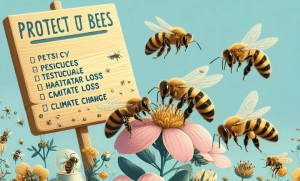
Disease and Parasites in Bee Colonies
Common diseases and parasites affecting bee health
Bee health is critically challenged by various diseases and parasites that can devastate colonies if left untreated. The following are some of the most prevalent threats:
- Varroa Mites: Perhaps the most notorious parasite affecting honey bees, Varroa destructor attaches to bees and feeds on their bodily fluids. This weakens the bees and exposes them to additional viruses.
- American Foulbrood (AFB): This bacterial disease affects bee larvae, causing them to die within the cell. AFB can decimate entire colonies and is highly infectious, requiring stringent control measures.
- Nosema: This microscopic fungus affects honey bee intestinal health, leading to poor digestion and decreased lifespan. Infected bees may exhibit symptoms such as dysentery and reduced foraging capabilities.
- Chalkbrood: Caused by a fungal infection, it targets bee larvae, turning them into a black, dry “chalk-like” consistency. Although it tends to be less catastrophic than other diseases, significant infestations can weaken colonies.
- Deformed Wing Virus (DWV): Often linked to Varroa mite infestations, this virus causes malformed wings in bees and can severely impact the overall productivity of the hive.
These diseases and parasites not only threaten individual colonies but can also disrupt local ecosystems due to the loss of pollination services.
Methods for monitoring and controlling diseases in bee colonies
Effective monitoring and control of diseases and parasites are crucial for maintaining healthy bee colonies. Here are some methods beekeepers can implement:
- Regular Inspections: Routinely examining hives helps in identifying early signs of disease or parasite infestation. Beekeepers should lookout for unusual behavior, dead bees, or signs of stress in the colony.
- Screened Bottom Boards: These come in handy for monitoring Varroa mite levels. They enable mites to fall through while allowing bees to exit and enter freely, making it easier to assess mite populations.
- Testing for Pathogens: Periodic testing of bee larvae and adult bees can reveal the presence of diseases. Many labs offer services to check for pathogens like Nosema and American Foulbrood.
- Integrated Pest Management (IPM): Combining biological, cultural, and chemical controls can effectively combat bee pests and diseases. This strategy minimizes chemical use while promoting healthy colonies.
- Chemical Treatments: As a last resort, appropriately timed and correctly applied chemical treatments may help control populations of parasites like Varroa mites. However, care must be taken to avoid harming the bees and pesticide-resistant strains.
By employing these methods, beekeepers can take proactive steps to safeguard the health of their colonies, helping to ensure the long-term survival of bees in our ecosystem.

Agricultural Practices and Bee Health
Agricultural practices that harm bee populations
Agricultural activities are both vital for food production and a significant threat to bee health. Several practices can adversely affect bee populations, leading to declines in these essential pollinators:
- Pesticide Use: The application of synthetic pesticides, especially neonicotinoids, poses a severe risk to bees. These chemicals are potent neurotoxins that can disorient bees, impair their foraging abilities, and lead to increased mortality rates.
- Monocropping: Relying on a single crop variety can reduce biodiversity in farming landscapes. This limits the availability of food sources for bees, as they often depend on a diverse range of flowering plants for nectar and pollen.
- Habitat Destruction: Practices such as land clearing for agriculture or urban development can decimate natural habitats where bees thrive. Loss of wildflowers and nesting sites leads to a shortage of resources needed for bee survival.
- Overuse of Fertilizers: While fertilizers boost plant growth, excessive use can harm pollinators. High nutrient levels can lead to pesticide runoff and water pollution, affecting bee health indirectly through degraded ecosystems.
These harmful practices not only threaten the well-being of bee populations but also compromise agricultural productivity, given how reliant many crops are on bee pollination.
Sustainable farming methods to support bee health
Transitioning to sustainable farming methods can significantly benefit bees and enhance overall agricultural resilience. Here are some effective practices:
- Integrated Pest Management (IPM): This approach involves monitoring pest populations and using a combination of biological controls, cultural practices, and targeted chemical applications to manage pest problems while minimizing harm to beneficial insects like bees.
- Crop Rotation and Diversification: Rotating crops and planting a diverse array of plants can enhance soil health and provide varied foraging opportunities for bees. Crop diversity supports an array of flowering plants that can bloom at different times throughout the year.
- Organic Farming: Adopting organic practices helps eliminate synthetic pesticides and fertilizers, fostering a healthier habitat for bees. Organic farms often prioritize natural pest control methods and promote biodiversity.
- Establishing Pollinator-Friendly Habitats: Farmers can create buffer zones filled with native flowering plants around their fields. These areas can provide vital forage and nesting resources for bees while also improving ecosystem health.
- Educating Farmers: Providing training and resources on the importance of bee health within agricultural contexts can encourage the adoption of sustainable practices among farmers.
By implementing these sustainable agricultural practices, farmers can protect bee populations, ensuring the health of these vital pollinators while maintaining productive, resilient agricultural systems.
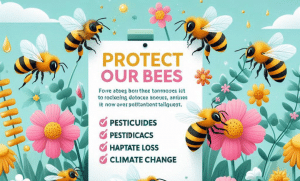
Recap of the top threats to bee health
The health of bee populations worldwide is declining due to several pressing threats that intertwine and amplify one another. The main challenges include:
- Climate Change: Alterations in climate patterns disrupt the natural cycles of flowering plants, leading to mismatched timings between bees’ emergence and food availability.
- Habitat Loss and Fragmentation: Urbanization, agricultural expansion, and deforestation lead to significant reductions in safe nesting sites and diversity of forage plants. This creates an unsafe environment for bees.
- Invasive Plants and Species: Non-native plant species and pests compete with native flora and fauna, which can diminish available resources for local bee populations.
- Low Genetic Diversity: Many bee populations suffer from low genetic diversity, making them more susceptible to diseases and environmental changes.
- Pathogens from Commercially Managed Bees: The movement of bee colonies can introduce diseases and parasites, further threatening wild bee populations.
Understanding these threats is vital for promoting initiatives that support the health and well-being of bees, as they play an essential role in our ecosystems and agriculture.
Actions individuals can take to help protect bee populations
Every individual can contribute to protecting bees and enhancing their habitats through various actionable steps:
- Plant a Pollinator Garden: Creating a pollinator-friendly garden filled with a diversity of native wildflowers ensures bees have access to pollen and nectar throughout the growing season. This helps support their nutrition and serves as a nesting area.
- Avoid Pesticides: Opt for organic gardening practices that do not use harmful pesticides, especially during peak blooming times when bees are most active. Educating others about the impact of chemicals on bee health is equally essential.
- Support Local Beekeepers: Purchasing honey and other bee-related products from local beekeepers helps bolster local bee populations and promotes sustainable practices.
- Educate Yourself and Others: Share knowledge about the importance of bees and the threats they face. Encourage friends and family to participate in local conservation efforts.
- Join or Support Conservation Organizations: Get involved with local or national organizations focused on bee conservation. Your support can help fund research and initiatives aimed at protecting bees.
By taking these small but impactful actions, individuals can play a crucial role in the movement to protect bee populations, ultimately contributing to healthier ecosystems and robust agricultural systems. Every effort counts in sustaining these vital creatures.
How can we solve the problem of bees?
The challenges facing bee populations are daunting but not insurmountable. Collective action at local, regional, and national levels can lead to solutions that protect these vital pollinators. Here are key strategies to address the pressing issues facing bee populations:
Create Safe Habitats
One of the largest threats to bees is the lack of safe habitats where they can thrive. Creating spaces that support bee populations is paramount. Individuals and communities can take the following actions:
- Plant Pollinator Gardens: Design gardens specifically with bees in mind. Use a variety of native plants that provide nectar and pollen throughout different seasons. This range of shapes, sizes, and colors will not only attract bees but also support butterflies and other pollinators.
- Maintain Natural Landscapes: Allow natural areas in parks and gardens to flourish without intervention. Leaving wildflowers and native plants intact can create essential foraging grounds for bees.
Reduce Pesticide Use
Pesticides, particularly neonicotinoids, pose significant risks to bee health. To mitigate this, consider:
- Going Organic: Choose organic gardening practices that avoid synthetic chemicals. This reduces the harmful impacts on beneficial insects like bees.
- Educate on Timing: If pesticides must be used, educate yourself and others about applying them during times when bees are less active, usually in the evening or when flowers are not blooming.
Support Local Beekeeping Initiatives**
Local beekeepers play a crucial role in sustaining bee populations. Support efforts related to beekeeping through:
- Purchasing Local Honey: Buying honey from local producers ensures that you are supporting environmentally sound practices and contributing to local ecosystems.
- Volunteer Opportunities: Join local beekeeping clubs or conservation groups to become actively involved in sustainable practices and learn more about bee health.
Advocate for Policy Changes
Engagement in environmental advocacy at a broader scale can enhance efforts to protect bees:
- Contact Legislators: Advocate for laws and regulations that protect pollinator habitats and restrict harmful pesticide use.
- Promote Climate Action: Support policies that address climate change aggressively, which is crucial for the long-term survival of bees.
By implementing these strategies, individuals and communities can work together to solve the problems facing bee populations, fostering a healthier environment for both the bees and the agriculture that relies on their pollination services. Every action counts in saving these indispensable creatures.
How to Save a Bee’s Life?
Bees are vital to our ecosystems and agricultural systems, and protecting them can sometimes mean rescuing individual bees in distress. Whether it’s providing immediate help to a bee you’ve found struggling or fostering a healthier environment overall, here are key strategies to save a bee’s life:
1. Provide Immediate Help to Distressed Bees
If you come across a bee that appears weak or unable to fly, consider a few gentle methods to help it recover:
- Provide Sugar Water: Mix a solution of sugar and water (about 1 part sugar to 2 parts water). Using a small spoon or dropper, offer a few drops near the bee. This sugary solution mimics the nectar bees collect and can provide a quick energy boost.
- Find Shelter: If a bee is resting on the ground, gently place it on a flower or secure it in a safe location away from foot traffic. This allows the bee to recuperate in a safe environment.
2. Create a Bee-Friendly Habitat
Long-term solutions to save bees involve ensuring they have a safe place to thrive. Here’s how you can contribute:
- Plant Native Wildflowers: Create a pollinator garden filled with a diverse range of native flowers. Since many bee species have coevolved to rely on these plants, they are essential for their survival—providing vital nectar and pollen.
- Ensure Blooming Diversity: Plant flowers that bloom at various times throughout the seasons. This guarantees that bees have consistent access to food throughout the growing period.
3. Go Chemical-Free
Reducing chemical exposure is critical for bee survival. Here are steps to follow:
- Choose Organic Practices: Avoid synthetic pesticides, fertilizers, and herbicides that can have detrimental effects on bee health. Opting for organic gardening methods fosters a safer environment for bees.
- Educate the Community: Share information about the dangers of pesticides with friends and neighbors. Encourage them to make bee-friendly choices in their gardens.
4. Advocate for Bee Protection
Raising awareness about the importance of bee conservation can also play a vital role in saving their lives:
- Support Local Beekeepers: Engage with local beekeeping initiatives and buy honey from local producers to support sustainable practices.
- Join Conservation Efforts: Participate in local conservation groups focused on habitat preservation and bee health advocacy, as collective efforts can bring about significant change.
By taking these actions, you not only have the power to save a bee’s life but also ensure that bee populations continue to thrive, ultimately benefiting our ecosystems and food systems as a whole. Every effort counts in the ongoing battle to protect these essential pollinators.
How Do You Make Bees Healthier?
Ensuring the health and vitality of bee populations is crucial for maintaining biodiversity and supporting agricultural ecosystems. Here are several effective strategies individuals and communities can implement to foster healthier bees:
1. Create Bee-Friendly Habitats
One of the most effective ways to promote bee health is by providing safe and nutritious habitats. Consider these steps:
- Plant Pollinator Gardens: Design gardens filled with diverse native flowers that bloom at different times throughout the year. This guarantees a consistent supply of nectar and pollen, essential for the diets of bees and their offspring.
- Use Diverse Plant Species: Incorporate various flower shapes, sizes, and colors to attract different bee species. This diversity helps cater to the specific needs of various pollinators.
2. Reduce Chemical Exposure
Minimizing the use of pesticides and other harmful chemicals directly contributes to healthier bee populations:
- Go Organic: Choose organic gardening practices that eschew synthetic pesticides, herbicides, and fertilizers. These substances can disrupt bee health and impair their immune systems.
- Educate Others: Raise awareness within your community about the negative impacts of chemical usage on bee populations and promote safer alternatives.
3. Support Local Beekeepers and Conservation Efforts
Engagement with local beekeeping initiatives can make a significant impact on bee health:
- Buy Local Honey: Purchasing honey and other bee products from local beekeepers supports sustainable practices and helps maintain healthy local bee populations.
- Participate in Conservation Programs: Join or support ecological initiatives aimed at protecting habitats and enhancing bee health. Many organizations focus on restoration projects that benefit pollinators.
4. Encourage Education and Awareness
Knowledge-sharing is crucial for fostering a culture that prioritizes bee health:
- Host Workshops: Organize or attend workshops that focus on bee conservation, gardening for pollinators, and the importance of maintaining biodiversity.
- Develop Educational Materials: Create pamphlets or online content that outlines the benefits of healthy bee populations and what individuals can do to contribute.
5. Monitor Bee Health
Keeping an eye on bee populations can also facilitate better health outcomes:
- Participate in Citizen Science Projects: Engage in community monitoring efforts or educational programs that track bee populations and health indicators.
By implementing these strategies, individuals can play an actionable role in making bees healthier and, consequently, more resilient. Every person can contribute to this crucial cause, ensuring that these invaluable pollinators continue to thrive for future generations. With combined efforts focused on creating supportive environments, the outlook for bee populations can significantly improve.
How Do You Help Bees Recover?
Helping bees recover from the myriad challenges they face requires a combination of individual actions and community efforts focused on creating supportive environments. Here are some effective strategies to assist in the recovery of bee populations:
1. Create Safe and Nutritious Habitats
One of the most significant threats to bees is the lack of safe habitats with abundant food sources. You can start making a difference by:
- Planting Bee Gardens: Establish gardens filled with a variety of pollinator-friendly, native flowers. Opt for plants that produce pollen and nectar throughout different seasons, ensuring a continuous food supply.
- Choosing Diverse Plant Varieties: Incorporate a wide range of flower shapes, sizes, and colors to attract various bee species. This diversity provides options for differing bee preferences and needs.
2. Adopt Chemical-Free Practices
Minimizing exposure to harmful chemicals is crucial for the health of bees:
- Go Organic: Embrace organic gardening practices that avoid synthetic pesticides, herbicides, and fertilizers. These chemicals can disrupt bee health and affect their immune systems.
- Educate Community Members: Share knowledge about the dangers of pesticides with your neighbors. Encourage sustainable gardening practices that prioritize bee well-being.
3. Support Local Beekeeping Initiatives
Engaging with local beekeepers can significantly contribute to bee recovery:
- Buy Local Honey and Products: Support local beekeeping by purchasing honey and other bee products. This not only benefits local economies but also promotes sustainable practices in your area.
- Volunteer with Beekeeping Associations: Many organizations need volunteers for various activities, including educational outreach and habitat restoration efforts. Your involvement can help both bees and local beekeepers.
4. Engage in Bee Conservation Efforts
Get involved with conservation initiatives focused on protecting bee habitats and promoting awareness:
- Join Local Conservation Programs: Participate in initiatives aimed at restoring natural habitats, creating pollinator corridors, and enhancing the biodiversity of areas where bees live.
- Advocate for Policy Changes: Support legislation that prioritizes bee health and habitat protection. Engaging in advocacy can help raise awareness and promote systemic changes that benefit pollinators.
5. Raise Awareness and Educate Others
Changing perceptions about the importance of bees is key to their recovery:
- Host Community Workshops: Organize events aiming to educate community members about the significance of bees and how to create bee-friendly environments.
By implementing these practical steps and encouraging others to do the same, individuals can play a significant role in the recovery of bee populations. Together, we can create a more sustainable world where bees can thrive, benefiting our ecosystems and agriculture alike. Every small action contributes to a larger movement toward bee conservation and health.
As we wrap up our exploration of the top threats to bee health and the steps we can take to help, I’m eager to hear your thoughts. What actions are you considering to support our vital pollinators in your own backyard? Together, we can make a difference in combating the challenges bees face, from climate change to habitat loss. Share your ideas in the comments below, and let’s work towards a healthier, bee-friendly world! Thank you for joining us on this important journey!
Important Notice on Content Rights
All rights reserved to Bees Partners © 2025. Copying, republishing, translating, or quoting more than 10% of this content is prohibited without prior written permission. For commercial or academic use, please contact: info@beespartners.dk.
Note: Limited quotation is allowed with clear source attribution and a direct link to the original article.


